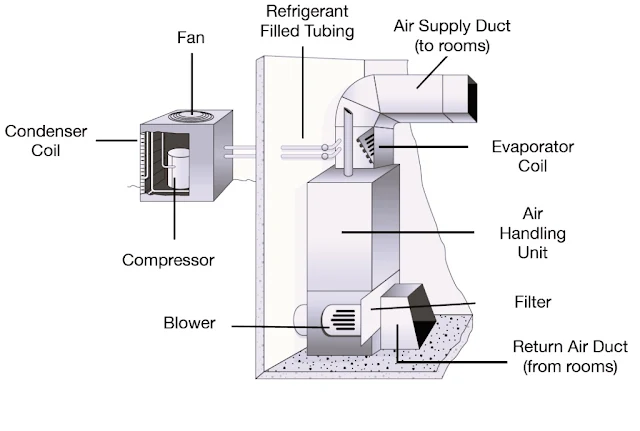What is HVAC?
HVAC stands for heating, ventilation, and air conditioning. Sometimes, people include refrigeration in it, making it HVACR. But what does all this jargon really mean? Well, HVAC is a way to control the climate inside your home or any indoor space. It's all about making sure the temperature and air quality are just right for the people or things inside.
HVAC isn't just for making a room feel warmer in the winter or cooler in the summer. It's also responsible for keeping the air clean and fresh. When it's cold outside, HVAC warms up the air, and during hot days, it cools it down.
So, What's an HVAC System?
An HVAC system is like a team of equipment working together. Its job is to provide heating and cooling while making sure the indoor environment is comfortable. These systems use mechanical, electrical, and control components to achieve this. Whether it's a cozy home, a big building, or even an industrial space, HVAC systems are there to keep the place comfortable and protect whatever's inside.
In big industrial places, HVAC also helps keep machinery working smoothly by controlling their temperature. So, HVAC systems aren't just for homes; they're everywhere.
What's Inside an HVAC System?
An HVAC system is made up of several important parts, such as:
- HVAC water chillers and heaters: These help control the temperature of the water used in the system.
- Hot water generator (if the chiller only produces chilled water) or a furnace: These warm up the water for heating.
- Pumps for chilled water and cooling water: They move the water around.
- Electrical power supply control or Motor control center (MCC): These make sure everything runs smoothly.
- Cooling towers: They help in the cooling process.
- Pipes for chilled water and cooling water: These carry the water.
- Valves for chilled water and cooling water: These control the flow of water.
- Air handling units (AHUs), heating coils, and cooling coils: These are responsible for managing the air.
- Ducts in the ventilation system: They are like air highways, delivering the air where it's needed.
- Fan Coil Units (FCUs) and thermostats: These are like mini climate controllers.
- HVAC Diffusers and grills: They help distribute the air.
- HVAC controls (instrumentation & Control components) installed at various locations: These are like the brains of the system.
- HVAC Control and Building Management System (BMS): This is like the control center for the whole building.
When you put all these parts together, you have a fully functioning HVAC system.
How Does an HVAC System Work?
Now, let's see how it all comes together. In the HVAC system, a water chiller cools water, which then travels through the building. This chilled water helps cool the air in the air handling system.
Blowers blow air over the cooling coils, and this cooled air is sent to different parts of the space to make it comfy. Air is pumped through supply ducts and returned air is stored in air handling systems. Pumps keep the water flowing, and valves are used to control the system.
When it's cold outside, the HVAC system can use a heat pump, a hot water generator, or a furnace to warm the air. In this case, heating coils replace the cooling coils to make things toasty.
Types of HVAC Systems
HVAC systems come in various types to suit different needs:
- Individual Air Conditioning System: This is used for a single room. It could be a small window unit or a split system with an indoor and outdoor part.
- Space Air Conditioning System: These systems handle the cooling, heating, and filtration for a whole space.
- Packaged Air Conditioning System: These can be a single packaged unit or two split units, one indoor and one outdoor. They use a cooling process with coils and heating methods like gas furnaces, electrical heating, or heat pumps.
- Central Air Conditioning System: This system uses cold and hot water to control the air temperature in the entire building. Water is great at transporting energy, so it's super efficient. Central systems can be built on-site for large structures.
So, there you have it. HVAC systems come in different shapes and sizes to fit all sorts of spaces, making sure you stay comfortable, no matter where you are. As time goes on, we're learning more and more about HVAC and finding new ways to make it even better.
FAQ
1. What does HVAC stand for?
HVAC stands for Heating, Ventilation, and Air Conditioning. It also sometimes includes Refrigeration (HVACR).
2. What are the main components of an HVAC system?
The key components of an HVAC system include water chillers, heaters, pumps, air handling units (AHUs), fans, ducts, thermostats, and control systems.
3. How does an HVAC system work?
An HVAC system works by circulating chilled or heated air through ducts, using water chillers, pumps, and cooling or heating coils to control the temperature of a space.
4. What are the different types of HVAC systems?
Types of HVAC systems include individual air conditioning systems, space air conditioning systems, packaged air conditioning systems, and central air conditioning systems.
5. Why is HVAC important?
HVAC systems are vital for maintaining indoor comfort by controlling temperature, air quality, and humidity levels, ensuring both comfort and safety.


